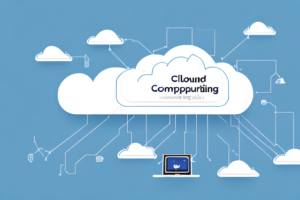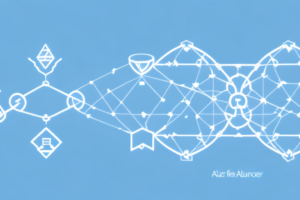Azure Kubernetes Service (AKS) vs Azure Service Fabric
8 min read
Two interconnected cloud-based computing systems
When it comes to container orchestration and microservices, Microsoft Azure offers several options. Two of the most widely used options are Azure Kubernetes Service (AKS) and Azure Service Fabric. While both platforms can help deploy applications and microservices, they have significant differences in the management of containers, security, scalability, and performance. In this article, we will explore the key differences between AKS and Service Fabric, and which one is better suited for your application needs.
What is Azure Kubernetes Service (AKS)?
Azure Kubernetes Service (AKS) is a popular managed Kubernetes service that deploys containerized applications and orchestrates them. It offers features such as auto-scaling, self-healing, and rolling updates. Kubernetes is an open-source platform that automates the deployment, scaling, and management of containerized applications. It is widely used in the industry and offers a large community of users and contributors.
AKS also provides integration with other Azure services such as Azure Active Directory, Azure Monitor, and Azure Virtual Networks. This allows for seamless integration and management of resources within the Azure ecosystem. Additionally, AKS offers a simplified deployment process through the use of Azure DevOps and other CI/CD tools. This makes it easier for developers to deploy and manage their applications on AKS.
What is Azure Service Fabric?
Azure Service Fabric is a platform for building and managing microservices. It is highly scalable and fault-tolerant, providing features such as automatic scaling, partitioning, and state management. Service Fabric is designed to simplify the development of microservices and reduce the time it takes to deploy and manage them.
One of the key benefits of Azure Service Fabric is its ability to handle both stateful and stateless microservices. This means that developers can choose the best approach for their specific application needs, without having to worry about the underlying infrastructure. Additionally, Service Fabric provides built-in support for containerization, making it easy to deploy and manage microservices in a containerized environment.
Key differences between AKS and Service Fabric
The main difference between AKS and Service Fabric is the level of abstraction they provide. While AKS is a managed Kubernetes service, Service Fabric provides a more comprehensive platform for building and managing microservices. Service Fabric offers native support for .NET and Java, whereas AKS supports any language that can run in a container. AKS provides more options in terms of container networking, whereas Service Fabric relies on its own networking infrastructure.
Another key difference between AKS and Service Fabric is their approach to scaling. AKS uses Kubernetes’ built-in scaling capabilities, which allows for horizontal scaling of containers based on resource usage. Service Fabric, on the other hand, uses a more granular approach to scaling, allowing for scaling of individual microservices based on their specific needs. This can be particularly useful for applications with varying levels of demand across different services.
Pros and cons of using AKS for container orchestration
AKS has many benefits, such as its integration with Azure ecosystem, support for any programming language, and robust performance. It allows the deployment of highly scalable applications and offers a large community of contributors. However, AKS requires more management and configuration than Service Fabric, which can be a disadvantage for some organizations. It also has less native support for .NET and Java applications.
Another advantage of using AKS is its ability to easily integrate with other Azure services, such as Azure Active Directory and Azure Monitor. This allows for better security and monitoring of your containerized applications. Additionally, AKS provides automatic scaling of your application based on demand, which can save costs and improve performance. However, it is important to note that AKS may not be the best option for smaller organizations with limited resources, as it can be more complex to set up and manage compared to other container orchestration solutions.
Pros and cons of using Service Fabric for microservices
Service Fabric offers many benefits, such as its built-in support for .NET and Java, simplified management of microservices, and highly scalable architecture. It also provides several features, such as rolling upgrades, stateful services, and partitioning. However, Service Fabric has a steeper learning curve than AKS and requires more setup and management. It also has less flexibility in terms of container networking.
Another advantage of using Service Fabric is its ability to handle both stateful and stateless services, allowing for greater flexibility in designing microservices. Additionally, Service Fabric provides robust monitoring and diagnostics capabilities, making it easier to identify and troubleshoot issues in a microservices architecture. However, it is important to note that Service Fabric may not be the best choice for smaller projects or teams with limited resources, as its complexity and management requirements may outweigh its benefits in those scenarios.
Which one is better suited for your application needs?
The choice between AKS and Service Fabric ultimately depends on the needs of your applications. If you have a large number of microservices written in .NET or Java, and want a platform to manage them with ease, then Service Fabric is the better choice. However, if you want to deploy containerized applications in any programming language with scalability and robust performance, then AKS would be a better fit.
It’s important to note that AKS and Service Fabric both offer different levels of control and customization. Service Fabric provides more control over the infrastructure and allows for more customization of the application runtime environment. On the other hand, AKS abstracts away the infrastructure and provides a simpler deployment experience.
Another factor to consider is the level of support and community resources available for each platform. AKS has a larger community and more resources available, making it easier to find help and troubleshoot issues. Service Fabric, on the other hand, has been around longer and has a more established support system in place.
Understanding the architecture of AKS and Service Fabric
The architecture of AKS and Service Fabric has similarities, such as container orchestration, auto-scaling, and load balancing features. However, AKS relies on Kubernetes for container management, while Service Fabric uses its own runtime for managing microservices. AKS offers more flexibility in terms of container networking, while Service Fabric has built-in clustering features.
Another key difference between AKS and Service Fabric is their approach to stateful applications. AKS relies on external storage solutions, such as Azure Disk or Azure Files, for persistent storage of data. On the other hand, Service Fabric provides built-in support for stateful services, allowing for easier management and scaling of stateful applications.
Additionally, AKS and Service Fabric have different deployment models. AKS is a fully managed service, meaning that Microsoft handles the underlying infrastructure and maintenance tasks. Service Fabric, on the other hand, can be deployed on-premises or in any cloud environment, giving users more control over their infrastructure and deployment options.
Deployment options for AKS and Service Fabric
Both AKS and Service Fabric allow deployment on-premises or in the cloud. AKS can be deployed in Azure or any other cloud provider, while Service Fabric can be deployed in Azure, on-premises, or even in other cloud providers. Both platforms also offer integration with container registries, such as DockerHub, and source code repositories, such as GitHub.
When it comes to scaling, AKS and Service Fabric offer different options. AKS allows for horizontal scaling, which means adding more nodes to the cluster to handle increased traffic. Service Fabric, on the other hand, offers both horizontal and vertical scaling, which means adding more nodes or increasing the resources of existing nodes to handle increased traffic.
Another difference between AKS and Service Fabric is their focus on container orchestration. AKS is primarily focused on Kubernetes, while Service Fabric offers support for both Kubernetes and its own proprietary orchestration system. This means that AKS may be a better choice for organizations that are already using Kubernetes, while Service Fabric may be a better choice for organizations that want more flexibility in their container orchestration.
Scalability and performance comparison between AKS and Service Fabric
AKS and Service Fabric both offer scalable architectures that can adjust to changing workloads. However, AKS offers better scalability for containerized applications, while Service Fabric is more optimized for microservices that need to scale independently. In terms of performance, AKS has a slight edge over Service Fabric due to its integration with Kubernetes, which has a large community of contributors and is widely used in the industry.
Another important factor to consider when comparing AKS and Service Fabric is their pricing models. AKS charges based on the number of nodes in the cluster, while Service Fabric charges based on the number of cores used. This means that AKS may be more cost-effective for smaller workloads, while Service Fabric may be more cost-effective for larger workloads that require more cores. It’s important to carefully evaluate your workload and usage patterns to determine which platform will be more cost-effective for your specific needs.
Security features comparison between AKS and Service Fabric
Both AKS and Service Fabric offer built-in security features, such as role-based access control (RBAC), network security, and encryption. AKS has more extensive security features that integrate with Azure Security Center and Azure Active Directory. Service Fabric also provides several security features, such as PowerShell-based management for deploying SSL certificates and granular access control.
One of the key differences between AKS and Service Fabric is the level of control over security that each platform provides. AKS allows for more granular control over network security, with the ability to configure network policies and control traffic flow between pods. Service Fabric, on the other hand, offers more control over application-level security, with the ability to configure custom security policies for individual services.
Another important consideration when comparing the security features of AKS and Service Fabric is the level of automation provided. AKS offers automated security updates and vulnerability assessments through Azure Security Center, while Service Fabric provides automated patching and updates for the underlying infrastructure. This can be an important factor for organizations looking to minimize the risk of security breaches and ensure that their systems are always up-to-date with the latest security patches.
How to migrate from Service Fabric to AKS or vice versa?
Migrating from Service Fabric to AKS or vice versa can be a complex process, involving several steps such as containerizing applications, updating configuration files, and changing networking settings. It is recommended to use a third-party migration tool or consult with a cloud migration specialist to ensure the smooth transition of applications.
Use case examples for choosing AKS or Service Fabric
If you have a mobile application that needs to be highly scalable and has a high number of containers, then AKS is the ideal choice. However, if you have a large number of microservices in .NET or Java that need to be managed from a single platform, then Service Fabric is the better choice. Service Fabric is also well-suited for applications that need to be highly available and fault-tolerant, such as e-commerce websites and financial applications.
Pricing comparison between AKS and Service Fabric
Both AKS and Service Fabric have a pay-as-you-go model, with pricing based on the number of nodes, storage, and data transfer. There are also options for reserved instances and discounts for enterprise customers. You should consult with Azure pricing calculator to determine the best pricing option for your specific use case.
Conclusion: Which one should you choose?
Choosing between AKS and Service Fabric depends on several factors, such as the size and complexity of your applications, the need for scalability and fault-tolerance, and the preferred programming languages. AKS is ideal for containerized applications that need to be highly scalable and performant, while Service Fabric is better for managing microservices written in .NET or Java with ease. Ultimately, the choice between AKS and Service Fabric should be based on the specific needs of your applications and your organization’s infrastructure.



